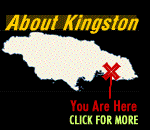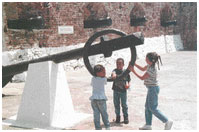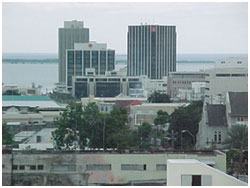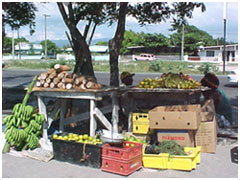Jamaica WI St Catherine Montego Bay
 mRepeatedly devastated by fire, flood, earthquake and hurricane, not to mention real Kingstonestate developers and urban planners, Kingston is a city with very little visible history but its long and colourful past has been well documented. It began in 1692 as a refuge for the survivors of the
mRepeatedly devastated by fire, flood, earthquake and hurricane, not to mention real Kingstonestate developers and urban planners, Kingston is a city with very little visible history but its long and colourful past has been well documented. It began in 1692 as a refuge for the survivors of the Kingston was born amidst a government scandal, the first many through the years.
Sir William Beeston returned to the island soon afterwards as governor and fortuitously discovered that the sale of this land to the government had not been legal, so the lots had to be purchased individually from him. He also acquired by dubious means the shoal water fronting Harbour Street thus greatly increasing the value of his holding there. When the governor's wheeling and dealing came to light there was a public outcry, and Kingston was born amidst a government scandal, the first many through the years.
In the beginning the refugees, crowded into tents on Colonel Barry's hog Crawle, were tormented by mosquitoes and fevers and more than 2,000 died. The survivors hankered to return to Port Royal so for a long time no substantial buildings were erected, only huts built with boughs, but by the end of the eighteenth century there were more than 3,000 fine brick houses in the city.
Kingston's excellent natural harbour fostered trade and the naval wars of the eighteenth century brought traffic and prosperity. The carousing for which Port Royal had been notorious continued here amongst a population noted for their excessive eating and drinking. Most of the duty collected was paid on Madeira wine, while the slaves and poorer classes made do with a rum concoction called kill-devil .
As a centre of commerce and fashion, Kingston rapidly out-distanced the somnolent official capital in Spanish Town and in 1755 the governor passed an act transferring the government offices to Kingston. The decision caused controversy, with those against it arguing, that life in Kingston would be destructive of the morals of Assemblymen. The next governor rescinded the Act.
Kingston continued to grow despite calamities: a devastating hurricane in 1784, a huge fire in 1843, a cholera epidemic in 1850 and another fire in 1862. In 1872 the capital was once again transferred to Kingston and this time it remained.
In 1907 an earthquake destroyed most of the city and killed 800 people. A visiting circus was encamped on the Racecourse and many of the survivors found temporary shelter under the big top. This earthquake accounts for the lack of historic buildings and for Jamaica's strict building code. After the quake an ordinance prohibited the erection of buildings higher than 60 feet. The first to exceed this height were the three storey public buildings on King Street. Constructed of reinforced concrete, they were considered at the time the last word in progressive architecture.
Originally the city had been laid out in a compact square enclosed by North Street, West Street, East Street and the sea. Over the years it absorbed the peripheral villages and pens spreading across the Liguanea plain and into the foothills of the Blue Mountains, in the process consuming some of the best agricultural land in the island.
In 1923 the local government bodies of the parishes of Kingston and adjacent St Andrew were amalgamated to form the Kingston and St. Andrew Corporation. Kingston has always had a history of energetic municipal elections. Here began the tradition of burying unsuccessful political candidates in a mock funeral procession complete with coffin and joyful mourners. The custom continues but the tempo and temperature of national elections have escalated considerably. Unfortunately political rallies can no longer be neutralized by the simple ploy of singing the national anthem just as the main speaker is due to appear.
Kingston's schizophrenia began quite recently. In the old days true Kingstonians boasted of being born beneath the clock of Kingston Parish Church. Today the well-to-do live uptown while the poorer classes live below the bridge (Torrington Bridge) in politically polarized ghettoes nicknamed Southside, Rema, Jungle and Lizard Town where it is never safe to stray too far away from home. But it is here that the creativity of the Jamaican peaks:
Kingston ghettoes produced Reggae, Bob Marley and the current musical phenomenon of Dancehall.
During the 1960s the city expanded north and the once famous Knutsford Racetrack became New Kingston.
With the development of New Kingston and a string of uptown shopping plazas the former commercial and shopping centres of King Street and Harbour Street became neglected and shabby. As an antidote to decay the government created the Kingston Waterfront Redevelopment Company to reclaim, redesign and upgrade 95 acres along the waterfront.
The project produced a nucleus of wide landscaped boulevards and multi-storey buildings which include the Bank of Jamaica, Scotia Bank Centre, the Jamaica Conference Centre, and Kingston Mall. Casualties of the redevelopment process were the once famous Myrtle Bank Hotel, the picturesque finger piers jutting out from Port Royal Street, and historic Victoria Market, scene of traditional Sunday and Christmas markets for over a hundred years.
In the 1980s another redevelopment program was undertaken by governments Urban Development Company. The massive project, assisted by a loan from the Inter American Development Bank comprised traffic rationalization and development of the market area south and west of the Parade, refurbishing the four main markets (Jubilee, Queens, Redemption Ground and Coronation) and building 6 additional markets. You will have already discovered that Jamaica is a nation of shopkeepers, vendors and higglers . It is estimated that at peak periods close to 15,000 vendors use this area and as much as J$25 million may change hands over a weekend. Because so many vendors and shoppers come in from the rural and suburban areas, the transport centre is a key component of the redevelopment plan.
The Kingston Restoration Company, created in the mid-1980s with U.S.. $6.8 million seed money from USAID, is an attempt to cure downtowns inner city . To spark conservation of the decaying downtown areas, KRC distributes grants towards the restoration of strategic buildings; to create employment it acquires and renovates derelict buildings and then leases them out for light industry. To defuse the time-bomb of poverty it sponsors social programs.
Kingston commands the seventh largest natural harbour in the world and sits athwart major shipping lanes: import, export and transhipment are big business here. The Port Authority of Jamaica administers extensive and modern shipping facilities at Port Bustamante, which include 11 lateral berths built by two private companies Western Terminals Ltd. and Kingston Wharves Ltd. The port area is a hive of activity and all too frequently the source of hair-raising reports alleging intrigue, corruption and smuggling. Kingston harbour is now so severely polluted by sewage, industrial effluent and oil spills that it has been called the cess-pit of the Caribbean. To date no serious attempt has been made to rehabilitate the marine environment although UWI scientists designated the problem critical some twenty years ago.
Adjacent to the port, the Kingston Free-Zone offers tax havens and excise exemption for export businesses and employs a large workforce mostly in garment factories. There are three other Free-Zone areas in the island, one of them close by on Marcus Garvey Drive.
Behind the port, the industrial section is home of some long established and prestigious firms like J. Wray & Nephew, distillers of Appleton rum, Desnoes and Geddes, brewers of Red Stripe beer, and Estate Industries, makers of Tia Maria Coffee Liqueur.
|
|







